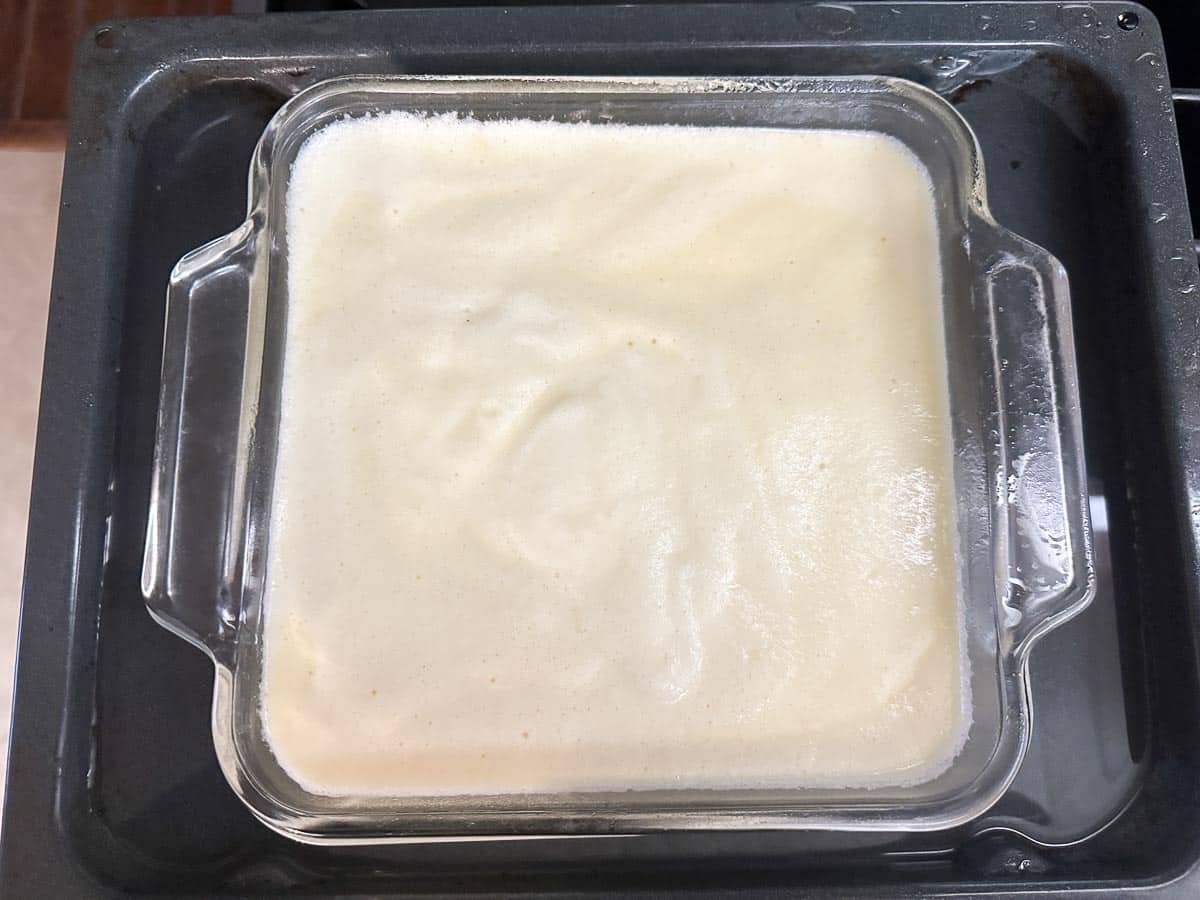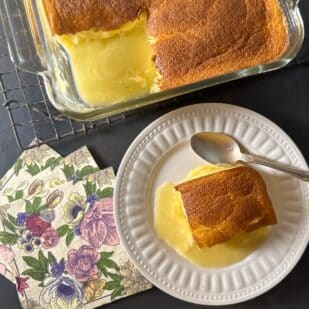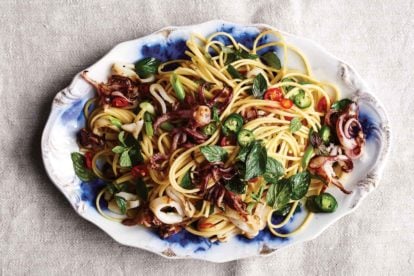Our Low FODMAP Lemon Pudding Cake is light, tangy, and sweet, all at once – and very easy to make. You whip up a very loose cake-like batter, bake it in a square ceramic or ovenproof glass dish, and the result is a spongey cake layer on top, with loads of creamy, tart lemon saucy pudding underneath. It’s gluten-free and lactose-free too.

The only “trick” is assessing doneness, so read the recipe through so you know what to do. And this is best served warm, so plan that accordingly as well.

You can have warm, Low FODMAP Lemon Pudding Cake in an hour!

Frequently Asked Questions
Pudding cake are an old-fashioned American dessert, made from ingredients homemakers have around. A batter lightened with whipped egg whites separates into a top cake layer and a saucy bottom layer, all in one dish. Serve warm for maximum sauciness.
No. Please don’t. This dish is all about lemon. It is for lemon lovers! You need fresh Lemon zest, so you are going to need whole lemons anyway. Zest your lemon first, with a rasp style zester for a very fine fluffy lemon zest, then go onto juice your lemons. Three medium lemons or two large should give you enough juice.
Roll your lemons around on your counter to loosen up the flesh inside and they will give you their maximum juice content.
Make Pudding Cake!
Position rack in middle of oven. Preheat oven to 350°F (180°C). Have ready an 8-inch square (20 cm) ovenproof glass or ceramic dish set inside a roasting pan. Coat the inside of the 8-inch pan with nonstick spray.
In a small bowl gently whisk together the sugar, flour, and salt.

Beat egg yolks, lemon juice, butter, and lemon zest together in a large bowl with an electric mixer until combined. The mixture will be very liquidy.

Slowly and gently beat in the flour mixture and the milk alternately until a wet batter forms.

Beat egg whites in a clean, grease-free bowl until soft peaks form.

Scoop about a quarter of the whites on top of the cake batter and whisk gently to begin combining…

…then add the rest of the whites and finish combining with a large silicone spatula.

Pour into prepared baking dish. Pour hot water tap water into roasting pan to come up the sides of the 8-inch (20 cm) pan about ½-inch.

Place roasting pan in oven and bake for about 30 to 40 minutes. You can test with a toothpick by inserting into the cake portion of the dish and it will come out clean. You should be able to see a distinct pudding layer on the bottom when you view the dish from the sides.

Let pan cool for 5 minutes on top of the stove or on a rack.

For best results, serve warm, simply scooping out into small bowls or plates. Serve with a spoon so you can get all the pudding, along with your cake!

FODMAP Information
All recipes are based upon Monash University & FODMAP Friendly science at time of initial publication.
- Butter: Both Monash University and FODMAP Friendly have lab tested butter. Monash states that a low FODMAP Green Light portion is 1 tablespoon or 19 g and also states that “butter is high in fat and does not contain carbohydrates (FODMAPs)”. FODMAP Friendly gives it a “Pass” at 1 tablespoon or 19 g. Both recommended serving sizes are presented as part of healthy eating guidelines, not as maximum FODMAP serving size. Fat can affect guy motility and trigger IBS symptoms in some people. Eat to your tolerance.
- Eggs: Eggs are high in protein and do not contain carbohydrates, according to Monash University.
- Lactose-Free Dairy: Lactose-free dairy, such as lactose-free milk or lactose-free cream cheese, has lactase enzyme added that breaks the disaccharide molecules and creates a more digestible dairy product, from a lactose perspective. The resulting product is not dairy-free, but it is lactose-free. Some products might have miniscule amounts of lactose remaining, but the amount is small enough for the product to be labeled as lactose-free. For instance, Breyers Lactose-Free Vanilla Ice Cream states it is 99% lactose-free, while Lactaid Vanilla Ice Cream states it is 100% lactose-free.
- Lemon Juice: Monash University has lab tested lemon juice and it is low FODMAP in ½ cup (125 g) amounts.
- Sugar: Monash University and FODMAP Friendly have both lab tested white, granulated sugar. Monash states that a Green Light low FODMAP serving size of white sugar is ¼ cup (50 g). FODMAP Friendly simply states that they have tested 1 tablespoon and that it is low FODMAP. Regular granulated white sugar is sucrose, which is a disaccharide made up of equal parts glucose and fructose. Sucrose is broken down and absorbed efficiently in the small intestine. As the fructose is never in excess of the glucose, white sugar will never be high FODMAP, even in large amounts.
Please always refer to the Monash University & FODMAP Friendly smartphone apps for the most up-to-date lab tested information. Foods will be retested from time to time; in the case of raw ingredients, such as fruits and vegetables, results may vary. All lab tested results are valid and represent a snapshot in time. As always, your tolerance is what counts; please eat accordingly. The ultimate goal of the low FODMAP diet is to eat as broadly as possible, without triggering symptoms, for the healthiest microbiome.


Low FODMAP Lemon Pudding Cake
Our Low FODMAP Lemon Pudding Cake is light, tangy, and sweet, all at once – and very easy to make. You whip up a very loose cake-like batter, bake it in a square ceramic or ovenproof glass dish plate and the result is a spongey cake layer on top, with loads of creamy, tart lemon pudding underneath. It’s gluten-free and lactose-free too.
Ingredients:
- 1 ¼ cups (248 g) sugar
- 6 tablespoons (70 g) low FODMAP, gluten-free all-purpose flour, such as Bob’s Red Mill 1 to 1 Gluten Free Baking Flour
- ½ teaspoon salt
- 4 large eggs, separated
- ⅓ cup (75 ml) freshly squeezed lemon juice
- 1 tablespoon unsalted butter, softened, cut into small pieces
- 1 tablespoon lemon zest, made with a rasp-style zester
- 1 ½ cups (360 ml) lactose-free whole milk, at room temperature
Preparation:
-
Position rack in middle of oven. Preheat oven to 350°F (180°C). Have ready an 8-inch square (20 cm) ovenproof glass or ceramic dish set inside a roasting pan. Coat the inside of the 8-inch pan with nonstick spray.
-
In a small bowl gently whisk together the sugar, flour, and salt.
-
Beat egg yolks, lemon juice, butter, and lemon zest together in a large bowl with an electric mixer until combined. The mixture will be very liquidy.
-
Slowly and gently beat in the flour mixture and the milk alternately until a wet batter forms.
-
Beat egg whites in a clean, grease-free bowl until soft peaks form. Scoop about a quarter of the whites on top of the cake batter and whisk gently to begin combining, then add the rest of the whites and finish combining with a large silicone spatula. Pour into prepared baking dish.
-
Pour hot water tap water into roasting pan to come up the sides of the 8-inch (20 cm) pan about ½-inch (12 mm). Place roasting pan in oven and bake for about 30 to 40 minutes. You can test with a toothpick by inserting into the cake portion of the dish and it will come out clean. You should be able to see a distinct pudding layer on the bottom when you view the dish from the sides. Let pan cool for 5 minutes on top of the stove or on a rack.
-
For best results, serve warm, simply scooping out into small bowls or plates. Serve with a spoon so you can get all the pudding, along with your cake!
Notes:
FODMAP Information
All recipes are based upon Monash University & FODMAP Friendly science at time of initial publication.
• Butter: Both Monash University and FODMAP Friendly have lab tested butter. Monash states that a low FODMAP Green Light portion is 1 tablespoon or 19 g and also states that “butter is high in fat and does not contain carbohydrates (FODMAPs)”. FODMAP Friendly gives it a “Pass” at 1 tablespoon or 19 g. Both recommended serving sizes are presented as part of healthy eating guidelines, not as maximum FODMAP serving size. Fat can affect guy motility and trigger IBS symptoms in some people. Eat to your tolerance.
• Eggs: Eggs are high in protein and do not contain carbohydrates, according to Monash University.
• Lactose-Free Dairy: Lactose-free dairy, such as lactose-free milk or lactose-free cream cheese, has lactase enzyme added that breaks the disaccharide molecules and creates a more digestible dairy product, from a lactose perspective. The resulting product is not dairy-free, but it is lactose-free. Some products might have miniscule amounts of lactose remaining, but the amount is small enough for the product to be labeled as lactose-free. For instance, Breyers Lactose-Free Vanilla Ice Cream states it is 99% lactose-free, while Lactaid Vanilla Ice Cream states it is 100% lactose-free.
• Lemon Juice: Monash University has lab tested lemon juice and it is low FODMAP in ½ cup (125 g) amounts.
• Sugar: Monash University and FODMAP Friendly have both lab tested white, granulated sugar. Monash states that a Green Light low FODMAP serving size of white sugar is ¼ cup (50 g). FODMAP Friendly simply states that they have tested 1 tablespoon and that it is low FODMAP. Regular granulated white sugar is sucrose, which is a disaccharide made up of equal parts glucose and fructose. Sucrose is broken down and absorbed efficiently in the small intestine. As the fructose is never in excess of the glucose, white sugar will never be high FODMAP, even in large amounts.
Please always refer to the Monash University & FODMAP Friendly smartphone apps for the most up-to-date lab tested information. Foods will be retested from time to time; in the case of raw ingredients, such as fruits and vegetables, results may vary. All lab tested results are valid and represent a snapshot in time. As always, your tolerance is what counts; please eat accordingly. The ultimate goal of the low FODMAP diet is to eat as broadly as possible, without triggering symptoms, for the healthiest microbiome.
Nutrition
All nutritional information is based on third-party calculations and should be considered estimates. Actual nutritional content will vary with brands used, measuring methods, portion sizes and more. For a more detailed explanation, please read our article Understanding The Nutrition Panel Within Our Recipes.
Kitchen mascot, Nora the mini bull terrier, helps take pics!

Nora thinks she has me fooled: “Mom, I am NOT looking at that pudding cake!”

She was a good girl. She gets a taste!








